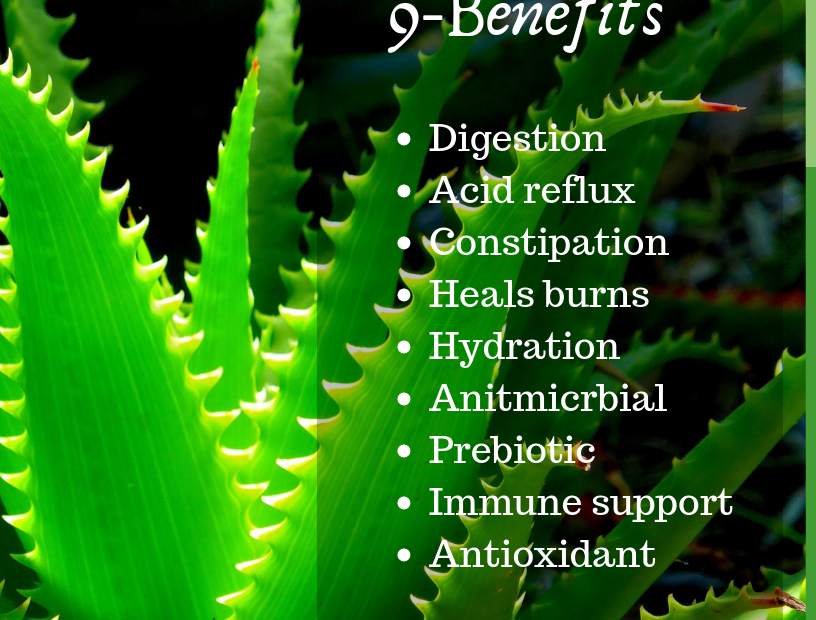Healing and Rejuvenating Herb, Aloe Vera
 The aloe vera plant is a succulent plant species from the genus Aloe and is part of the lily family.It grows abundantly in tropical climates and has been used for centuries as a medicinal plant.
The aloe vera plant is a succulent plant species from the genus Aloe and is part of the lily family.It grows abundantly in tropical climates and has been used for centuries as a medicinal plant.
The name Aloe vera derives from the Arabic word “Alloeh” meaning “shining bitter substance,” while “vera” in Latin means “true.” Greek scientists regarded Aloe vera as the universal panacea. The Egyptians called Aloe “the plant of immortality.”
Ayurveda and Aloe Vera
In Sanskrit, aloe vera is ghrita kumaraand has been used in Ayurvedic medicine for thousands of years. Aloe vera is especially beneficial to balance Pitta dosha, since aloe vera is sweet, astringent, cooling, rejuvenating and soothing. It has an affinity for the stomach and small intestine, the blood, and the female reproductive system. Aloe vera also pacifies Vata and Kapha dosha.
Aloe vera is often used as an anupan, or carrier substance in herbal formulas, for internal and external use. Anupans serve as a catalyst, or a moderator for the herbs to penetrate the tissues or channels in the body for optimal benefit.
Benefits
- Soothes rashes and skin Irritations
- Treats burns
- Heals cold sores
- Anti-bacterial
- Moisturizes hair and scalp
- Helps with digestion
- Reduces constipation
- Provides antioxidants and reduces inflammation
- Alkalinity-decreases overall body acidity supporting cellular health
- Hydration
- Prebiotic supports healthy gut bacteria
- Heartburn relief-inner fillet aloe vera juice helps to reduce acid production
- Anti-inflammatory
Active Components and Their Properties
- Antioxidant vitaminsA, C, E, B12, Folic Acid
- Enzymesthat reduce inflamation: aliiase, alkaline phosphatase, amylase, bradykinase, carboxypeptidase, catalase, cellulase, lipase, and peroxidase.
- Minerals to support the function of enzymes in the body: calcium, chromium, copper, selenium, magnesium, manganese, potassium, sodium and zinc.
- Anthraquinones that act as antimicrobials and laxatives: 12 anthraquinones, Aloin and Emodin.
- Fatty acids with anti-inflammatory and analgesic actions: 4 plant steroids; cholesterol, campesterol, β-sisosterol and lupeol.
- Hormones supporting would healing: Auxins and gibberellins.
- Others: Contains 20 of the 22 human amino acids, plus 7 of the 8 essential amino acids. Salicylic acid that has anti-inflammatory and antibacterial properties. Lignin, enhances penetrative effect of the other ingredients into the skin for topical application. Saponins,have cleansing and antiseptic properties. Acemannans and Fructans have prebiotic properties, promoting lactobacillus growth in the intestines.
Side Effects
Aloe latex or whole-leaf extract taken orally might be unsafe and is likely unsafe in high doses. Taking 1 gram a day of aloe latex for several days can cause acute kidney failure and can be fatal. Aloe latex might also have the potential to cause cancer. Other side effects include abdominal cramps, diarrhea, kidney problems, blood in the urine, low potassium, muscle weakness, weight loss, and heart disturbances. Oral use of aloe latex and whole-leaf extract isn’t recommended for children younger than age 12. Please seek medical advice before taking any herbs or herbal supplements.
Resources:
https://www.healthline.com/health/digestive-health/aloe-vera-juice-acid-reflux#benefits
https://www.medicalnewstoday.com/articles/318591.php
